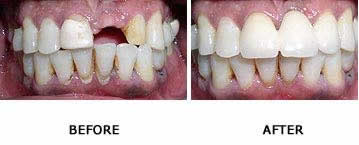FIXED BRIDGES
An excellent way to replace a missing tooth or teeth.
The Problem:- A missing tooth or teeth.
- Potential bite and jaw joint problems from teeth shifting to fill the space.
- The “sunken face” look associated with missing teeth.
- Inability to chew efficiently
- Fed up with wearing removable dentures.
- Defective smile due to missing teeth.
A bridge is an appliance that is typically attached to the tooth on each side of the space where a tooth is missing. An artificial tooth attached in the middle of the bridge fills in the gap where the missing tooth was. The teeth on either side of the gap are prepared for crowns (see crowns) and an impression or mold is made of the prepared area. This mold is used to create a porcelain (tooth-colored) or gold bridge in a dental laboratory. The bridge is then cemented onto the prepared surface of the teeth, effectively creating the appearance of a “new” tooth. It does not need to be removed by the patient.

In some instances, a resin-bonded bridge may be suggested. In this case, the teeth on each side of the gap are not prepared for crowns. Instead, the bridge consists of a replacement tooth containing ceramic or metal brackets that are bonded to the backs of the real teeth on each side. In certain situations, this can save a large amount of healthy tooth structure and be highly esthetic.
Advantages:Unlike dentures, a fixed bridge is never removed. It is stable in the mouth and functions like natural teeth. By filling the gap and stopping the movement of other teeth, a fixed bridge is an excellent investment. It provides increased chewing efficiency, helps to avoid possible bite or TMJ problems, and can be highly esthetic.
Disadvantages:Fixed bridges are excellent restorations and have few disadvantages. They are highly durable, but they may eventually need to be replaced due to normal wear.
Alternatives:In the event that a fixed bridge is not feasible or desirable, an excellent alternative is a dental implant.
